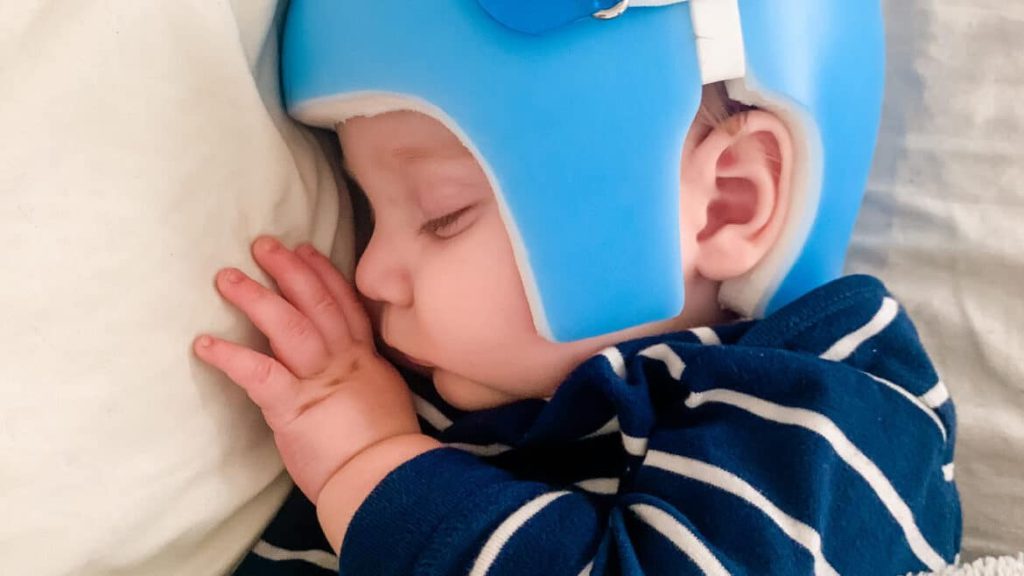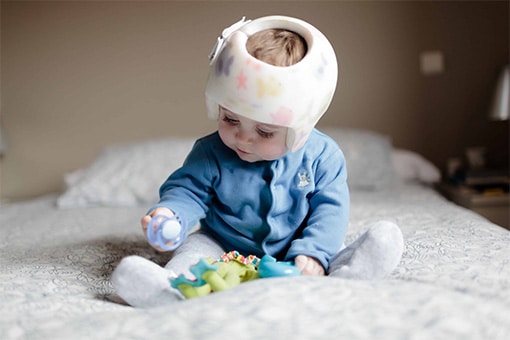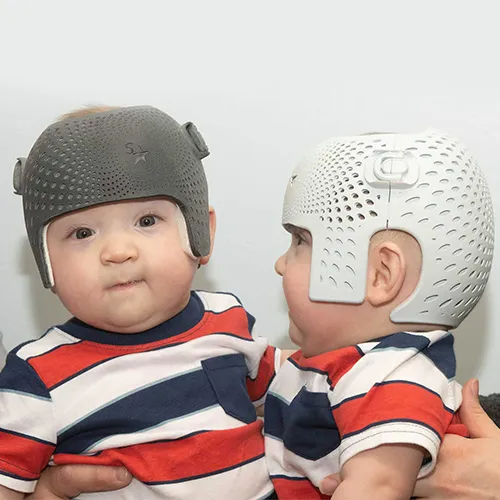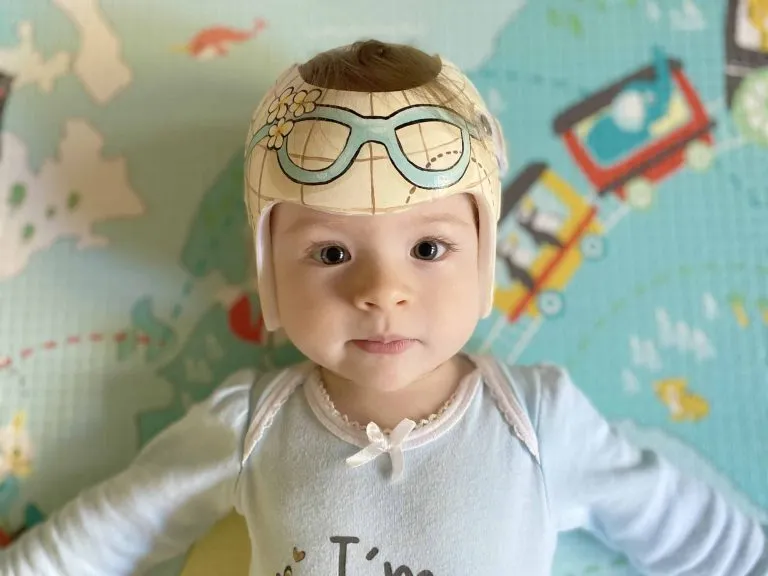
What is Baby Helmet Therapy: A Complete Parent’s Guide
Hey parents, have you noticed a flat spot or uneven head shape in your baby? You’re not alone. Many infants develop head shape issues like plagiocephaly, brachycephaly, or scaphocephaly, especially in the first few months. Sometimes the skull corrects itself naturally. But when it doesn’t, baby helmet therapy can help.
Also called infant helmet therapy, this safe, non-invasive treatment gently guides your baby’s skull into a rounded, symmetrical shape. In this detailed and easy-to-understand guide, we’ll cover everything you need to know, from how it works to when it’s needed, and how effective helmet therapy really is.
A Quick Guide to the Different Types of Flat Head Syndrome
1. Plagiocephaly: The baby’s head should be flattened on one side, which makes it misaligned. The forehead and the head may bulge on the flat side.
2. Brachycephaly: The back of the head becomes flat, which makes it broader and shorter.
3. Scaphocephaly: The head would be long and elongated, common in premature babies.
4. Craniosynostosis: This is also known as congenital plagiocephaly, which is also a serious birth defect with the skull’s fibrous joints close prematurely.
Understanding Infant Head Growth & Development
1. Restricted Growth
There are different causes of an infant’s typical head development: in-utero restraints, constraints, neck muscle dysfunction, torticollis, preferred positioning, and supine position dependency. Hence, repositioning within the first three to four months is the most effective way of counseling head asymmetry and proportion.
2. Unrestricted Growth
At six months, babies start rolling, sitting, and touching. As a result, the head size increases proportionately, but babies don’t have an endocranial cast that realigns facial distortions. The enlargement may conceal differences in asymmetry, and significant changes demand resistive forces within certain spheres.
3. Directed Growth
Broad skull slight variations are normal and usually do not represent a problem. However, suppose the child has a moderate or severe deformity that may persist after repositioning. In that case, the parent may consider getting the baby a cranial remolding helmet, usually called an infant head shaper or baby head-shaping helmet. These devices use mild force to control skull development in areas with minimal volume. The doctor says wearing a cranial helmet therapy promotes early treatment to gain the best results quickly.
What is Baby Helmet Therapy ?
Baby helmet therapy is also known as cranial remolding or using infant head shaping helmets. These helmets apply gentle pressure to flatten the prominent parts of the skull and give room for the flat areas to grow.
It’s a safe, customized, and pain-free treatment that helps in correcting skull asymmetry in babies when natural repositioning hasn’t worked. The earlier you start, the better.
Why Do Babies Develop Flat Heads?
Some of the most common causes include:
- Sleeping in the same position for too long
- Torticollis (tight neck muscles)
- Premature birth
- Multiple births (twins, triplets)
- In-utero positioning
That’s why tummy time, upright positioning, and gentle repositioning are so important during the early months.
How Do I Know If My Baby Needs a Helmet?
You should consider a medical evaluation if:
- Your baby has a visibly flat spot on the head
- There’s facial asymmetry (like uneven eyes or ears)
- Repositioning has not improved the shape by 4–6 months
A pediatrician or cranial specialist can assess the severity and guide you on the next steps. Mild cases may resolve naturally, while moderate to severe cases may need helmet therapy for flat head correction.
How Effective Is Infant Helmet Therapy, and Is Treatment Really Needed?
Helmet therapy is highly effective, especially when started between 4 and 6 months. Studies and clinical experience show that:
- It improves head symmetry significantly
- It works faster in younger infants
- It’s non-invasive and doesn’t interfere with brain development
Helmet therapy is recommended only when needed, after repositioning fails or in moderate to severe cases. Starting earlier leads to shorter treatment times and better outcomes.
“It is preferred that helmet therapy be begun before the child is one year old to attain the best outcome. Let us assist you in this and help your child have a healthy and solid head for a great future.”
Can Flat Head Syndrome or Plagiocephaly Helmets Cause Brain Damage?
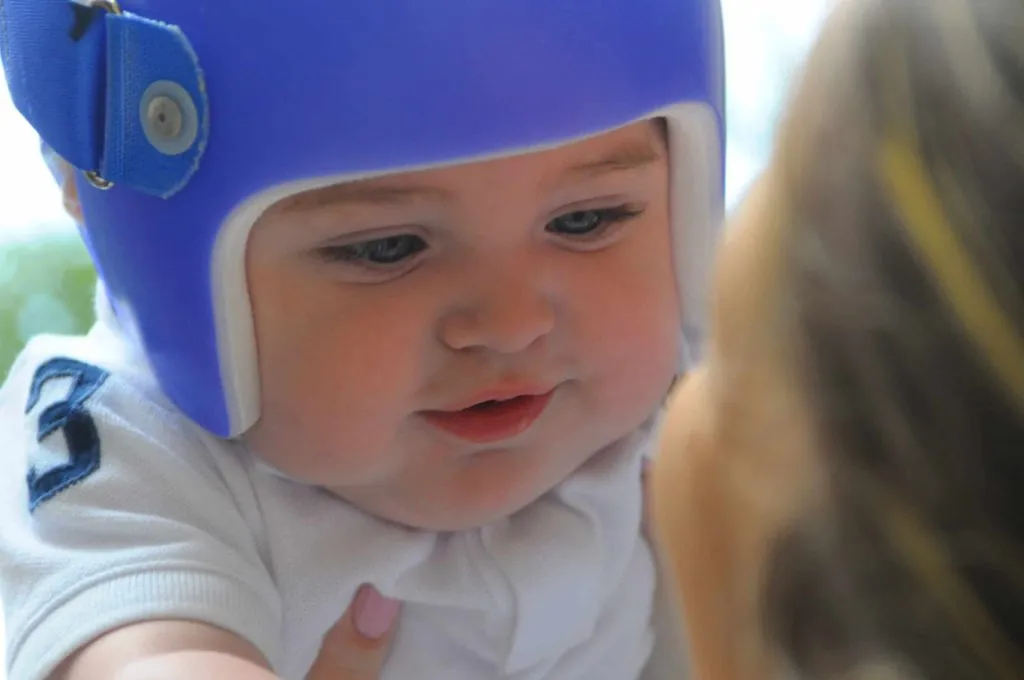
Absolutely not. Cranial helmets for infants are designed to be soft on the inside and custom-fit to your baby’s head. They guide the natural growth of the skull without applying harmful pressure.
They are medically approved and do not affect brain development in any way. They only shape the external skull while the brain continues to grow normally.
Does Plagiocephaly Need Surgery to Correct It?
In most cases, no. Plagiocephaly and brachycephaly are typically treated without surgery using repositioning and helmet therapy. However, if your child has craniosynostosis, surgery may be required first. After surgery, helmet therapy helps guide the skull’s shape during healing.
What Happens After Completing Plagiocephaly Treatment?
Once your baby completes helmet therapy:
- The head shape usually remains consistent
- No further treatment is needed unless new flattening occurs
- Regular follow-ups may be advised to monitor growth
Early and complete treatment gives lasting results and a naturally shaped head.
What is the Best Helmet Therapy for Flat Head in India?
If you’re looking for flat head treatment in India, you’re in the right place. At KARE Prosthetics & Orthotics, we specialize in designing custom cranial helmets for infants.
Why choose KARE?
- Lightweight and comfortable helmets
- Advanced 3D scanning for precise fit
- Experienced orthotists and pediatric care team
- Gentle and supportive care throughout the process
Your baby’s safety and comfort are our top priority.
Ready to take the next step? Book a consultation with our specialists today.
FAQs
1. How Long Does Infant Helmet Therapy Take?
Most babies wear their helmets for 3 to 6 months, depending on severity and age. Helmets are worn 23 hours a day, with breaks for cleaning. Earlier intervention means faster results.
Progress is monitored regularly, and the helmet is adjusted to keep pace with your baby’s growth.
2. How to Fix a Baby’s Flat Head Without a Helmet
Mild flat spots often improve with:
- Tummy time during the day
- Alternating head positions during sleep
- Minimizing time in car seats and swings
- Carrying your baby upright
If there’s no improvement by 4–6 months, consult your doctor.
3. Cranial Helmets for Infants: How They Work
A cranial helmet has:
- A firm outer shell
- Soft foam lining inside
It gently restricts growth in prominent areas and allows expansion in flattened areas. Even if your baby continues to rest on one side, the helmet protects from further flattening.
Conclusion: Every Step Forward Counts
As a parent, noticing even a slight difference in your baby’s head shape can feel overwhelming. But remember, you’re not alone, and more importantly, your baby is not in danger. Flat head syndrome is common, manageable, and in most cases, completely treatable without surgery.
Helmet therapy is just one of the gentle ways to guide your baby’s head growth in the right direction. With the right support, early action, and expert care, your baby can grow with confidence, and so can you as a parent.
Key Takeaways
- Baby helmet therapy is a proven, safe method to reshape an infant’s flat or asymmetrical head.
- Most effective between 4 to 12 months
- Customized helmets ensure comfort and results
- Treatment usually lasts 3 to 6 months
- Works best when repositioning isn’t enough
Need Expert Advice?
Whether you’re concerned or simply exploring your options, reach out to our team at KARE Prosthetics & Orthotics. We’ll assess your baby’s head shape and recommend the best course of action, from repositioning tips to personalized infant helmet therapy.




